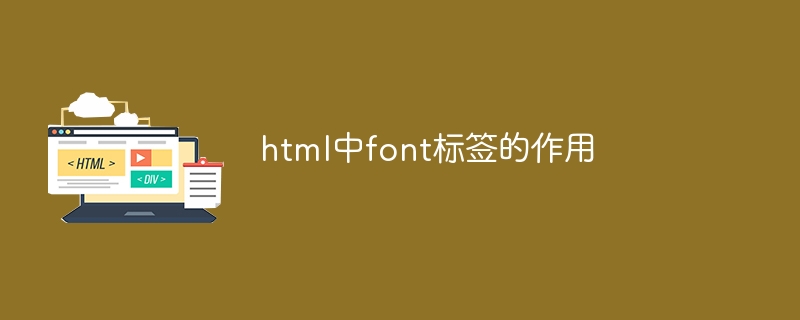The role of font tag in html
The FONT tag in HTML is used to define text font characteristics, including font family, size, color and style. The syntax is: Text, corresponding to the font family and size (relative to the default size) increase or decrease), color (hex code or color name) and style (such as bold, italic). Although the FONT tag is simple and easy to use, it has been deprecated in HTML5 and it is recommended to use CSS to control text styling because it provides more advanced control, semantic meaning, and browser compatibility.

The role of the FONT tag in HTML
The FONT tag is used to control text font characteristics in HTML documents. It allows developers to specify the appearance of text, including font family, size, color, and style.
How to use the FONT tag
The FONT tag has the following syntax:
<font face="Font family" size=" / -number" color="color" style="style">text</font>
- ##face:Specify the font family of the text, for example "Arial " or "Times New Roman".
- size: Specifies the relative change in the size of the text relative to the default size. Positive numbers indicate an increase, and negative numbers indicate a decrease.
- color: Specifies the color of the text, either using a hexadecimal code (for example, #FF0000 for red) or a color name (for example, "red").
- style: Specify the style of the text, such as "bold" (bold), "italic" (italic) or "underline" (underline).
Example
<font face="Arial" size="+2" color="blue" style="bold">这是使用 FONT 标签加粗、放大并加蓝色的文本。</font>
Advantages
- Easy to use: FONT tag The syntax is simple and easy to understand.
- Quick Apply: It quickly applies text style changes without using CSS.
Disadvantages
- Outdated: The FONT tag is deprecated in HTML5 and replaced by CSS.
- Lack of semantics: The FONT tag only controls the appearance of the text and does not provide any semantic information.
- Limited browser support: Some browsers no longer support the FONT tag, or only partially support it.
Recommended Practice
Nowadays, it is recommended to use CSS instead of FONT tag to control text style. CSS provides greater control, semantic meaning, and better browser compatibility.The above is the detailed content of The role of font tag in html. For more information, please follow other related articles on the PHP Chinese website!

Hot AI Tools

Undresser.AI Undress
AI-powered app for creating realistic nude photos

AI Clothes Remover
Online AI tool for removing clothes from photos.

Undress AI Tool
Undress images for free

Clothoff.io
AI clothes remover

AI Hentai Generator
Generate AI Hentai for free.

Hot Article

Hot Tools

Notepad++7.3.1
Easy-to-use and free code editor

SublimeText3 Chinese version
Chinese version, very easy to use

Zend Studio 13.0.1
Powerful PHP integrated development environment

Dreamweaver CS6
Visual web development tools

SublimeText3 Mac version
God-level code editing software (SublimeText3)

Hot Topics
 1378
1378
 52
52
 How to write split lines on bootstrap
Apr 07, 2025 pm 03:12 PM
How to write split lines on bootstrap
Apr 07, 2025 pm 03:12 PM
There are two ways to create a Bootstrap split line: using the tag, which creates a horizontal split line. Use the CSS border property to create custom style split lines.
 How to insert pictures on bootstrap
Apr 07, 2025 pm 03:30 PM
How to insert pictures on bootstrap
Apr 07, 2025 pm 03:30 PM
There are several ways to insert images in Bootstrap: insert images directly, using the HTML img tag. With the Bootstrap image component, you can provide responsive images and more styles. Set the image size, use the img-fluid class to make the image adaptable. Set the border, using the img-bordered class. Set the rounded corners and use the img-rounded class. Set the shadow, use the shadow class. Resize and position the image, using CSS style. Using the background image, use the background-image CSS property.
 How to resize bootstrap
Apr 07, 2025 pm 03:18 PM
How to resize bootstrap
Apr 07, 2025 pm 03:18 PM
To adjust the size of elements in Bootstrap, you can use the dimension class, which includes: adjusting width: .col-, .w-, .mw-adjust height: .h-, .min-h-, .max-h-
 The Roles of HTML, CSS, and JavaScript: Core Responsibilities
Apr 08, 2025 pm 07:05 PM
The Roles of HTML, CSS, and JavaScript: Core Responsibilities
Apr 08, 2025 pm 07:05 PM
HTML defines the web structure, CSS is responsible for style and layout, and JavaScript gives dynamic interaction. The three perform their duties in web development and jointly build a colorful website.
 How to use bootstrap in vue
Apr 07, 2025 pm 11:33 PM
How to use bootstrap in vue
Apr 07, 2025 pm 11:33 PM
Using Bootstrap in Vue.js is divided into five steps: Install Bootstrap. Import Bootstrap in main.js. Use the Bootstrap component directly in the template. Optional: Custom style. Optional: Use plug-ins.
 How to set up the framework for bootstrap
Apr 07, 2025 pm 03:27 PM
How to set up the framework for bootstrap
Apr 07, 2025 pm 03:27 PM
To set up the Bootstrap framework, you need to follow these steps: 1. Reference the Bootstrap file via CDN; 2. Download and host the file on your own server; 3. Include the Bootstrap file in HTML; 4. Compile Sass/Less as needed; 5. Import a custom file (optional). Once setup is complete, you can use Bootstrap's grid systems, components, and styles to create responsive websites and applications.
 How to use bootstrap button
Apr 07, 2025 pm 03:09 PM
How to use bootstrap button
Apr 07, 2025 pm 03:09 PM
How to use the Bootstrap button? Introduce Bootstrap CSS to create button elements and add Bootstrap button class to add button text
 How to view the date of bootstrap
Apr 07, 2025 pm 03:03 PM
How to view the date of bootstrap
Apr 07, 2025 pm 03:03 PM
Answer: You can use the date picker component of Bootstrap to view dates in the page. Steps: Introduce the Bootstrap framework. Create a date selector input box in HTML. Bootstrap will automatically add styles to the selector. Use JavaScript to get the selected date.




